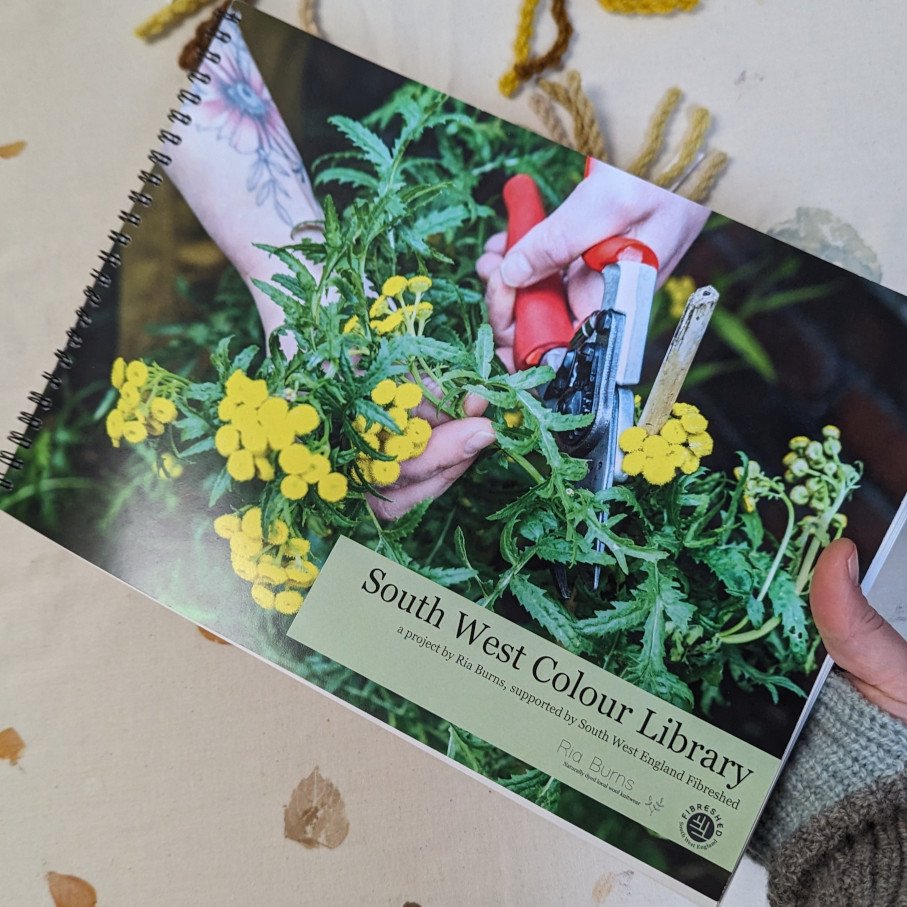The South West Colour Library - Building a Natural Dye Colour Map of Our Fibreshed
Introducing the South West Colour Library – a research project funded by South West England Fibreshed. The aim of the project is to build a bioregional library of natural dye plants and colour samples from across the region, with a focus on wild rather than cultivated plants.
As well as exploring the diversity of plants across the South West, I wanted to see how local water quality, soil and fibre affected the dye outcome. In summer 2023 I visited four sites to undertake place-based colour studies – Tamarisk Farm in Dorset, Lower Hampen in the Cotswolds, Baddaford in Devon and an urban study where I live in East Bristol.
I foraged for plants on the land and used them to dye small samples on wool yarn which was either sourced from their farm or as closely as possible. I used the water available on site ranging from hard tap to soft spring water with no modification added to the dye bath. The results were often quite surprising, although as you’d expect , there was quite a lot of yellow!
From these samples, after testing them for their light fastness (resistance to fading from sun exposure), I developed hyperlocal colour palettes to act as a source for inspiration and education. The South West Colour library is an open source document that is available for all to download here.
This blog post is an outline of the project - the case studies, methods and outcomes. For more detailed notes see the full PDF.
I also have made a print copy of the library containing physical yarn samples which will be available to view at upcoming events and workshops. I am available for in person or online talks or workshops around this project, or the more wider topic of natural dyeing - please get in touch to discuss ideas!
The Case Studies
The four case studies were selected to capture the broad range of landscape found across the region. All studies were undertaken in the Summer of 2023 when wild flora are at their most abundant.
Tamarisk Farm, Dorset, 10th June - Dorset Down DK
Lower Hampen Farm, Cotswolds, 20th June - Devon Closewool DK
Baddaford Collective, Devon, 10th July - Rushlade Dartmoor Merino DK
East Bristol, 18th July - Fernhill Shetland-Romney 4ply
Plants were gathered from pastures and uncultivated areas spread around each case study. A mixture of common dye plants and unknown wild plants were gathered.
For each case study, a ‘unique plant’ was chosen which represents the location best.
The Method
After foraging, each plant was then photographed before being chopped and added to ‘sous-vide’ style bags with water drawn from the site, and yarn. This method of dyeing enables multiples small samples to be dyed at the same time in the same pot, saving space and energy.
In each sample, 2 mini hanks of yarn were dyed. One was mordanted with alum and the other was not mordanted. No modification was made to the dye liquids; the colour outcome was influenced solely by the water and plants alone.
The Results
Click on the images below to enlarge them. The full document has photos of each plant for reference. There was a great variation in the plants and colours achieved, although yellow was the dominant colour.
Each dye outcome was influenced by more than just the plant itself. The yarn used, the water quality and soil all had an impact. This is why the same plant (e.g. Hawthorn) has produced different results in each case study - the Colour Library PDF explains this further.
Some natural dyes can fade through light exposure, as well as through washing and wear. It’s important to me that natural dyes have longevity, as the end product made with that dye is more likely to be cherished and used for longer than one that has faded.
I tested each sample for their lightfastness using a simple method outlined in the document. From this I selected the strongest (least or not faded) samples and built a colour wheel for each case study - a hyperlocal colour palette which can be viewed below:
Tamarisk Farm
Dyer’s greenweed
Bramble
Hawthorn
Wild privet
Pear leaf
Wild madder
Tamarisk
Comfrey
Dock root
Beech leaf
Holm oak
Lower Hampen Farm
Sanfoin
Yellow Rattle
Knapweed
Walnut leaf
Apple leaf
Rowan leaf
Ragwort
Hawthorn
White clover
Hedge bedstraw
Ladies bedstraw
Cherry leaf
Baddaford Collective
Ragwort
Pineapple weed
White clover
Black walnut leaf
Alder leaf
Yarrow
Hawthorn
Oak Leaf
Alder cone
East Bristol
Wild carrot
Yarrow
Horsetail
Tansy
Callery pear
Herb Robert
Hawthorn
Fig leaf
Final Thoughts and Ideas for Continuation
I really enjoyed undertaking this project - I found it challenging, but incredibly rewarding. I made new connections with fibre producers and farmers within our Fibreshed, and learnt to identify and use lots of wild plants.
The finale document is open source and designed to be an inspiration for both producers and designers. Please do use this resource to create your own place-based colour studies!
I would love this project to develop and expand further across the South West Fibreshed region, building a larger library of colour. For further case studies, I would like to investigate the use of plant based mordants to see if a suitable replacement for alum can be found. This will also increase the bioregional nature of the colours and improve sustainability of the dyes. The continuation of this project is subject to successful funding appliations.
If you are a farmer or fibre producer in the South West of England and would like me to survey the wild dye plants on your land, contact me at hello@riaburns.co.uk
I would welcome your feeback on the project - either leave a comment here or send me an email.

















